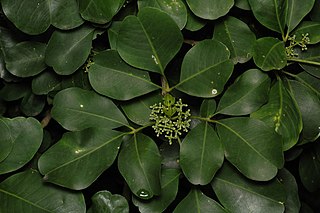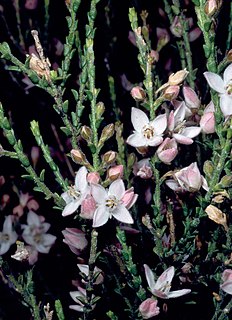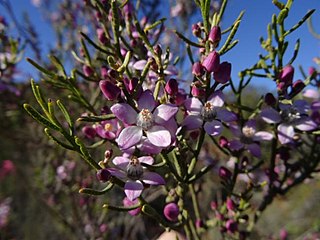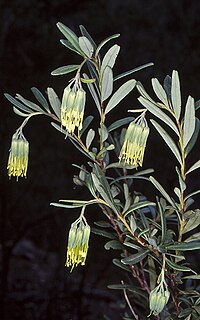
Phebalium nottii, commonly known as pink phebalium, is a species of shrub that is endemic to eastern Australia. It has branchlets with silvery scales, oblong to elliptical leaves, deep pink to mauve flowers arranged in umbels of up to six, with the stamens distinctively offset to one side of the flower.
Nematolepis frondosa, commonly known as leafy nematolepis, is a shrub that is endemic to Victoria, Australia. It is a small, conical shaped shrub with glossy leaves, scaly branchlets and white flowers in winter and spring.

Melicope polybotrya is a species of shrub or small tree in the family Rutaceae and is endemic to Lord Howe Island. It has trifoliate leaves and green flowers borne in short panicles in leaf axils.

Cyanothamnus baeckeaceus is a plant in the citrus family, Rutaceae and is endemic to eastern Australia. It is a slender or straggling shrub with simple or trifoliate leaves and pink and white four-petalled flowers. It is endemic to the south-west of Western Australia.

Philotheca brucei is a species of flowering plant in the family Rutaceae and is endemic to Western Australia. It is a shrub with cylindrical leaves grooved along the top and in spring, white to pink or mauve flowers with five egg-shaped petals.

Leptospermum brachyandrum is a species of shrub or small tree that is endemic to eastern Australia. It has smooth bark, linear to lance-shaped leaves and white flowers and usually grows along creeks, often in water.
Phebalium clavatum is a species of shrub that is endemic to Western Australia and is more or less covered with silvery scales. It has warty branchlets, more or less circular leaves with a large spherical gland and white flowers arranged singly on the ends of branchlets.

Phebalium festivum, commonly known as dainty phebalium, is a species of spreading shrub that is endemic to Victoria, Australia. It has smooth branchlets, broadly egg-shaped, warty leaves and three to ten white or pale yellow flowers arranged in umbels on the ends of branchlets.

Phebalium obcordatum, commonly known as the club-leaved phebalium, is a species of shrub that is endemic to New South Wales. It has smooth branchlets, small egg-shaped to heart-shaped leaves with the narrower end towards the base and small umbels of pale yellow flowers with silvery scales on the back of the petals.

Phebalium tuberculosum is a species of erect shrub that is endemic to Western Australia. It has glandular-warty and scaly branchlets and leaves and white flowers arranged in umbels of three or four with rust-coloured scales on the back of the petals.

Phebalium verrucosum is a species of shrub that is endemic to New South Wales. It has branchlets densely covered with white scales, narrow elliptic, oblong or linear leaves covered with white scales on the lower side, and umbels of creamy white flowers with silvery or rust-coloured scales on the back of the petals.
Leionema oldfieldii is a small shrub that is endemic to mountainous locations in Tasmania, Australia. It has dark green leaves, compact pale pink to white flowers from November to January.

Leionema ralstonii, is a small shrub with angular, smooth branchlets and pale green flowers in winter. It is restricted to the south coast of New South Wales.

Nematolepis ovatifolia, is a small shrub with rusty coloured scales on the stems, smooth, glossy leaves and white flowers in small clusters in summer. It is endemic to New South Wales.
Nematolepis rhytidophylla, is a dense shrub with angular stems, covered densely in coppery coloured scales, smooth, glossy leaves and white flowers in small clusters in winter and spring. It is endemic to New South Wales.

Philotheca tomentella is a species of flowering plant in the family Rutaceae and is endemic to the south-west of Western Australia. It is an undershrub with small club-shaped to cylindrical leaves and white flowers with a pale red central stripe, arranged singly or in groups of up to four on the ends of branchlets.

Prostanthera canaliculata is a species of flowering plant in the family Lamiaceae and is endemic to the south-west of Western Australia. It is a small, erect shrub with hairy branchlets, narrow egg-shaped to narrow elliptical leaves and pale blue or pale violet to white flowers with no markings.

Prostanthera grylloana is a species of flowering plant in the family Lamiaceae and is endemic to Western Australia. It is a small, erect shrub with densely hairy branchlets, small, spatula-shaped leaves and red to pink flowers.
Gompholobium polyzygum is a species of flowering plant in the family Fabaceae and is endemic to north-western Australia. It is an erect or prostrate shrub with pinnate leaves each with sixteen to twenty-one pairs of leaflets, and yellow-orange and greenish, pea-like flowers.
Pomaderris forrestiana is a species of flowering plant in the family Rhamnaceae and is endemic to south-western Australia. It is a low shrub with elliptic leaves, and small clusters of woolly-hairy flowers.














